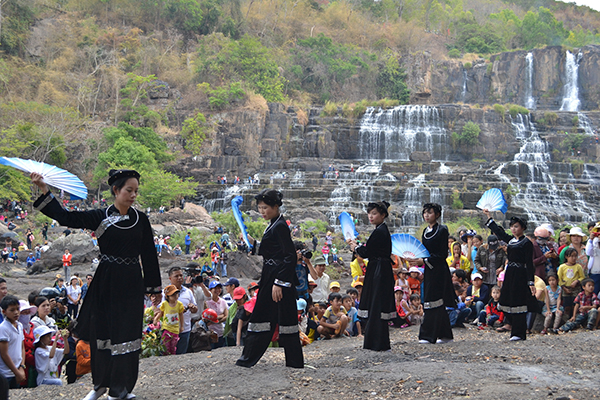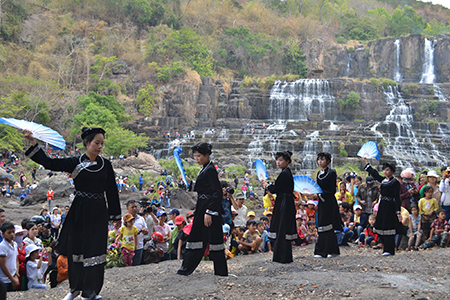Whoever comes back to visit the mountain district of Bac Son
Will remember the time when forest leaves were stained with blood
(...) The gold-starred red flags of guerrillas of the August Revolution
Fluttered over combat zones
O Bac Son, where enemy troops were destroyed
Bac Son, the area of forest and hills sheltering our military base!...
That winter evening the revolutionary song written by Van Cao, the author of our national anthem, was sung around a fire burning in a house-on-stilts in Bac Son, a district of the border province of Lang Son. The emotion felt in the voices of the singers, two former militants of the Viet Minh, Dr. Hoai and his colleague Hien, both in their seventies now, deeply moved their audience of Vietnamese pilgrims, who had participated in the August 1945 revolution and the First Resistance War, and their French and American companions.
Our group had started from Hanoi and travelled 79 kilometers by car before arriving in Thai Nguyen, capital of the province of the same. Thai Nguyen was the first town liberated by the Viet Minh following its foundation in 1941. In the first war of resistance (1945-1954) the northern highlands of Viet Bac were its stronghold with Thai Nguyen and Bac Can sheltering its headquarters. In the second war of resistance Thai Nguyen was razed to the group by American air bombings. It has been rebuilt and is now a municipality which boasts a richly documented Museum of Nationalities, a metallurgical industry, and a School of Culture and Art of Ethnic Minorities.
From Thai Nguyen we turned right to enter the province of Lang Son. After driving 77 kilometers along a rough road we came to Bac Son at sunset. Near the main street of the district centre a Tay village was bathed in the mist together with the limestone hills in the background. Most of its houses were built of bamboo and wood, a rarity now in the highlands where wood-and-bamboo; house-on-stilts have been replaced by brick ones built at ground level. The landscape before our eyes evoked a wash-drawing in the traditional Chinese style.

For a better understanding of the role played by Bac Son and its population of ethnic minorities at the time of the Revolution, we must come back to the year 1940 when the Japanese fascist army issued an ultimatum to the French colonial forces then occupying Vietnam (and Indochina). By way of intimidation the Japanese attacked the French garrison in Lang Son, which withdrew to Hanoi via Bac Son. The embryonic revolutionary forces of Bac Son, made up of members of ethnic minorities, with the support of the local population, availed themselves of the occasion to disarm the fleeing troops and seize military post of Vo Nhai. Many indigenous soldiers of the post joined the revolutionary forces.
Soon, however, Japanese with French complicity set about repressing the revolution. The Bac Son insurrection was crushed. Following a directive of the Communist Party, the Bac Son guerrillas under the command of Chu Van Tan (a member of the Nung minority who later became an army general) formed themselves into the first squads of the National Salvation Troops (Cuu Quoc Quan), who took refuge at the Chinese border from where they returned in 1943 to engage under Viet Minh command in operations of "armed propaganda" which contributed to the building of the first bases of the Viet Bac liberated zone. In late 1944, on order from Ho Chi Minh, Vo Nguyen Giap set up the first unit of the Armed Propaganda Brigade for the Liberation of Vietnam, In April 1945, it merged with the forces of the National Salvation troops to become the Liberation Army of Vietnam.
The Bac Son insurrection illustrated a historical truth: the traditional solidarity between the Viet majority ethnic group and the minorities. Economic solidarity between people living in the lowlands who needed forest products and highland people who needed salt and metal tools. Political solidarity when it came to fighting against foreign invaders: the Mongols in the 13th century, the Ming in the 15th, the French and Americans in the 19th and 20th centuries. The tatter two's policy of "Divide and Rule" was largely ineffective.
Let us come back to our brief visit to Tay village of Bac Son.Our foreign friends were greatly pleased by (heir participation in a Then ritual organized in a private home one evening. All the village was there to watch the dancing and listen to the singing.
The word Then designates the supernatural forces and also the shaman (usually a woman) who officiates in a ceremony comprising the performance of sacred music, song and dance. The ritual watched by us that evening was an act of exorcism aimed at warding off evil spirits which could harm the master of the house who had reached his 53rd year, an age believed to be the possible cause of misfortune. The shaman (Then) was a woman about 60 years of age clad in an indigo costume and surrounded by offerings of various kinds: food, paper votive objects, candles, incense... She sang a long poem to the accompaniment of a string instrument with a small round sounding-board and a long neck, and performed several sacred dances. The ceremony lusted several hours, until two or three in the morning.



